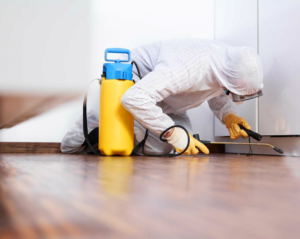Pests damage buildings, crops, and soil and transmit diseases to humans and animals. For example, pigeons carry disease-causing bacteria on their feathers that can make people sick.
Threshold-based decision-making involves scouting and monitoring to determine whether a pest infestation warrants control action. This helps you select the most effective management methods at the right time. Contact Pest Control in Bakersfield now!

Pests are more than just annoying; they can cause various problems that are both health hazards and property damage. Rodents, for example, gnaw through wires and can cause electrical damage, while rodent droppings may spread diseases such as leptospirosis, Salmonella, or Hantavirus. Pests such as fleas and cockroaches can pose serious health concerns, especially for those with allergies or immune system impairments.
Prevention strategies focus on keeping the environment unattractive to pests by removing food, water, and shelter sources. For example, a bird feeder or bath should be placed well away from the house, garbage should be disposed of regularly and stored in closed containers inside the home, and water leaks and standing water should be addressed. Additionally, clutter should be eliminated to reduce places where pests can hide and breed.
If an infestation occurs, scouting and monitoring should be done to identify the pest problem and determine what methods will work best for control. Threshold-based decision-making is often used; for example, noticing a few wasps or bees around the house may not warrant action. However, seeing more in increasing numbers may indicate a problem that requires attention.
Indoors, vacuum and wipe down surfaces regularly to remove dirt and other materials that pests use for hiding or breeding. Store foods in sealed containers inside the refrigerator, and keep pet food in secure containers when not feeding animals. Avoid over-watering plants, and time irrigation in the mornings when pests are less active.
When pests do invade, prompt treatment is essential to limit the extent of damage and prevent disease. When a pesticide product is used, it should be selected with the least environmental impact in mind and applied as recommended on the label. Spraying should be avoided in areas where children and pets play, and a targeted approach should be taken to minimize exposure.
Eradication is a goal that is rarely pursued in outdoor pest situations, but it is sometimes possible for enclosed environments such as dwellings; schools; offices; and health care, food processing, and food preparation facilities. Eradication techniques typically involve introducing more of the pest’s natural enemies or pathogens to the area, or using other methods such as the release of sterile organisms or pheromones.
Control
Pests can damage our buildings and gardens and spread diseases. They also annoy us and interrupt our daily lives. Luckily, there are a number of ways to stop them and keep pests under control. These include pest proofing, physical methods, biological controls and chemical methods.
The first step in controlling pests is to identify them and understand their habits. This will help you choose the best method of control. Pests may be insects or vertebrates, such as rodents and birds. Some, like mosquitoes and flies, can carry germs that can cause illness in humans and animals. Others, such as ants and termites, can cause structural damage to our homes.
Before taking any action, determine how serious the problem is. This involves scouting and monitoring. Noticing a few wasps in your yard occasionally probably doesn’t warrant any treatment, but seeing them regularly and in large numbers indicates an infestation. In addition, it’s important to know the difference between continuous pests, which are always present and need regular control, and sporadic or migratory pests that require treatment only occasionally or cyclically.
When using physical methods to prevent pests, it’s important to close off places where they can enter or hide. This includes caulking cracks, sealing gaps and installing screens. It’s also a good idea to remove food and water sources and reduce clutter. These steps will help eliminate a pest’s attraction and ability to breed.
Biological pest control uses natural organisms to destroy or parasitize unwanted pests. These organisms may be predators, such as lady beetles that eat aphids, or parasitoids, such as nematodes and wasps that live in or on the host insect and kill it from within. It’s also possible to use pathogens, which are microorganisms, such as bacteria, fungi and nematodes, that cause disease in pests.
Chemical pest control uses synthetic chemicals to destroy or disrupt the life cycle of a pest. They may be in the form of sprays, baits or traps. The key to successful chemical control is understanding the pest’s life cycle and selecting an appropriate chemical for each stage of the cycle.
Eradication
Pests disturb the environment by damaging soil and plants. They also cause diseases to humans and animals. They can be bacteria, fungus, birds, rodents, invertebrates like mites and ticks, or insects, or even nematodes. They are harmful to human health and the environment, and their presence can cause serious damage to buildings and their contents. The aim of pest control is to reduce the impact of these organisms on people, plants, and animals, and to restore balance in the ecosystem. This can be achieved through prevention, suppression, or eradication strategies.
Prevention is the most common strategy for controlling pests, although it can be difficult to implement in outdoor situations. Eradication is a less common goal, and it is usually reserved for foreign pests that have been accidentally introduced and need to be controlled before they establish themselves in an area. Eradication programs are typically supported by governments.
Eradication strategies include biological, cultural, and chemical controls. Biological control uses the pest’s natural enemies to limit its population, including parasites, predators, and pathogens. This is often combined with cultural controls, such as changing irrigation practices and reducing pesticide use. Chemical controls use pesticides to kill or deter the pests, and they can be used alone or in combination with other methods.
In museums, the goal of pest control is to prevent or reduce pests’ damage to artifacts. Museum staff can minimize the presence of pests by using good building design, maintenance, and sanitation; by controlling attractants; by establishing quarantine areas; and by treating collections with low temperature or controlled atmosphere fumigation.
Pests can enter museums through open windows, air vents, sewers, and water lines, as well as on artifacts carried in by visitors. Pests can also be introduced by staff or by equipment and merchandise on loan. Museum insect problems can be very difficult to solve, but they can be reduced by implementing preventive measures and using the most effective techniques. The terms exterminate, extirpate, and eradicate have similar meanings but differ in emphasis. Exterminate implies the extinction of a race, family, or species by killing them all; extirpate stresses driving them out or destroying them; and uproot refers to forcible removal and stressing displacement or dislodgement rather than destruction.
Monitoring
Pest monitoring is the underlying activity that drives all effective pest control strategies. It involves regular, detailed examination of crops, structures, landscapes and other sites for pests and their damaging effects. Monitoring techniques include scouting, trapping and sampling. The information gathered is used to determine whether the current level of pests threatens economic losses or poses health hazards or nuisances. It also guides decisions about the proper timing and methods for controlling a pest problem.
A common strategy in Integrated Pest Management is to establish action thresholds. These are specific levels of pest populations or damage that, once reached, require immediate pest control to prevent unacceptable losses or risks. Thresholds are set by comparing pest numbers with environmental conditions, such as weather and food or harborage availability. The monitoring data enables a grower to make more informed decisions about when and how to use cultural, biological and chemical control tactics.
Effective monitoring requires a systematic approach, incorporating scouting, tracking and inspection of crops, structures and other sites. It also includes assessing the impact of natural enemies and the environment on pest population dynamics. This helps reduce dependence on chemical pesticides and fosters more anticipatory approaches to pest control.
Once a decision is made to control an infestation, suppression and prevention are often mutual goals. Suppression reduces the number of pests to a low enough level that they no longer cause damage or are considered a nuisance. Prevention keeps pests from reaching unacceptable numbers in the first place, reducing the need for costly control measures.
In some situations, eradication is a goal. This is especially true for pests that are considered a public health risk, such as rodents and roaches in restaurants or other office buildings, or disease vectors like mosquitoes and flies in hospitals and other healthcare facilities. It may also be required under regulatory controls, such as those imposed by government agencies to protect public health and/or crop quality.
Pests are a serious concern for business owners, as they can compromise the safety of employees and customers. For this reason, businesses need to be proactive when it comes to protecting their premises from unwanted intruders. By working with a professional company that offers pest management and control services, businesses can focus on their core operations, knowing that they are protected from harmful pests.


